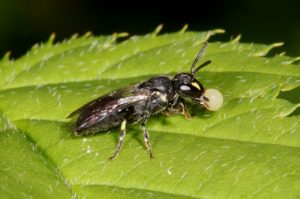Common yellow face bee (Hylaeus communis) blowing nectar bubbles film
I was fortunate enough to film this bee a Hyleus communis, in action on a hot sunny day. I did think that the bees would just blow one bubble and let it hang in the air to evaporate the water. However, this is not so. This female did it at least 11 times in my presence by blowing and sucking back inside then blowing out again. Goodness knows how many times she did this before and after I filmed. She does some manipulation with the bubble as she draws it back inside. I suppose I thought this because I have only ever seen photographs of the nectar bubble and not the actual blowing and sucking back actions. This is known as Water homeostasis.

Common yellow face bee blowing nectar bubbles to concentrate nectar by Ted Benton
Many bee species collect pollen and store it on their bodies or legs. Being so small makes this rather impractical for these minute bees. They are simply not physically capable of storing pollen on their tiny wasp-like bodies. They do not possess either a scopa or corbicula (pollen baskets) so what better way to forage is to drink and mix pollen with the nectar, storing it in the crop?
Then they concentrate this mixture by regurgitating it onto its proboscis which exposes it to the sun and wind. To you and I the bee is blowing bubbles known as ‘bubbling’, and then she sucks it back inside and repeats the same operation. Some flies do something similar. This evaporates the water. Excess water is not required by this small bee and is heavy for it to carry internally so evaporating it leaving nectar is a rather sensible behaviour for this tiny bee.
Water requirements
Nicolson states that nectar is a simple food consisting of varying proportions of sucrose, fructose and glucose dissolved in water. She continues that at high ambient temperatures, honeybees collect free water, which I have seen as they drink from my pond, whereas small solitary bees modify their foraging behaviour and seek out dilute nectars, which provides them with their water needs.
Bubbling
Why does this bee blow bubbles? To concentrate this fluid food resource they undertake ‘bubbling’ or water homeostasis, regurgitating the liquid mixture into a bubble to evaporate the water. The nectar is now concentrated and thick making it tacky like honey. You can see how fluid this mixture is and how the eggs and even the larvae ‘stick’ to its surface, unlike many other solitary bee larvae which ‘sit’ on top of the more solid pollen mixture. The concentrated liquid brood mass requires the larvae to ‘swim’ across it doing a kind of sidestroke, something that is unique to plasterer bees. You will see that the larvae, as shown in the film are a distinct “C” shape as they float on the tacky liquid surface.
Foraging trips
Just imagine for one minute the volume and weight of the nectar mixture inside one brood cell. How many tiny drops were collected, how many bubbles she blew, how many trips this would take and the extra weight of it as it was being transported. This is no mean feat!
Photography
A good thing about ‘bubbling’ is that the bee remains stationary so will be easier to photograph. No use in her moving around and risking spilling or contaminating her hard work obtaining nectar.
See the life cycle of the common yellow-face bee.
For more information about solitary bees see BWARS
For info and a link to buy an excellent book Field Guide to the Bees of Great Britain and Ireland by Steven Falk
An extremely useful resource that supports this book by a special website feature within Steve Falk’s Flickr website which furnishes extra photos and other useful resources to assist with identification.
Solitary Bees book by Ted Benton
Interested in Citizen Science and pollinators? (e.g. bees!) The Buzz Club

Recent Comments